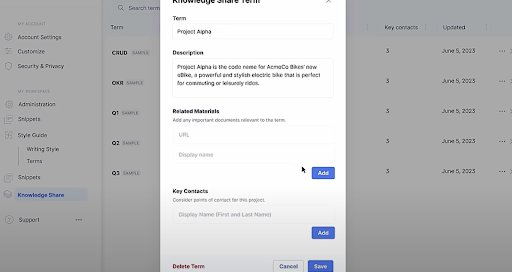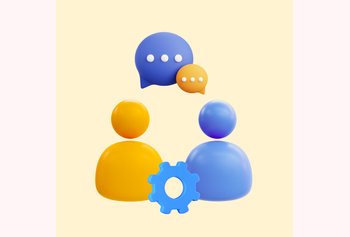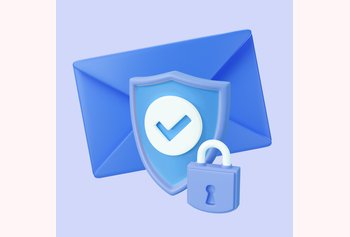10 Tips and Tools I Recommend to Improve Email Productivity

Table of contents
Let’s be real, nobody likes starting their day dealing with an overflowing and cluttered email inbox, and I’m no different. There used to be days where I wouldn’t know which emails to open first, which ones to respond to, and which ones to archive or delete.
This indecisiveness would slowly eat into my work hours and hamper my productivity.
So, I figured it’s time to change a few things. I did a lot of research online to figure out tips and tricks that can help me improve my email productivity. Basically, spend less time in my inbox but do more work.
I also tested out a couple of productivity tools just to see how well they could support me in maintaining a clutter-free inbox.
Read on to know more!
Table of Contents
- How to Improve Your Email Productivity
- 1. Set aside a specific time every day to sort through your emails
- 2. Organize your emails into folders
- 3. Use the 2-minute rule
- 4. Limit notifications
- 5. Use templates
- 6. Set up auto-responders
- 7. Batch process emails
- 8. Convert important emails into tasks
- 9. Use separate inboxes
- 10. Use email productivity tools
- 10 Email Productivity Tools for Managing Your Inbox
- Take Control of Your Inbox and Boost Email Productivity
How to Improve Your Email Productivity
Here are ten of my top tips to improve your email game.
1. Set aside a specific time every day to sort through your emails
The truth is your inbox can get too full too quickly if you don’t spare some time to attend to it every day. Incoming emails can pile up fast and before you know it you might be overwhelmed.
That also doesn’t mean that checking your emails throughout the day is the answer. It can get intrusive and cost you precious time. It’s important to find out a time slot that works for you. Spend at least 10-15 minutes every day to go through your inbox when you can delete unnecessary emails and prioritize the urgent ones.
A study by Harvard Business Review recommends tackling your inbox first thing in the morning. This is because your rational decision-making capacity declines throughout the day and pushing email correspondence to the end can drain your mental energy.
Pro Tip: Avoid switching between other tasks when you’re handling your inbox. This helps you stay focused on sorting new emails.
2. Organize your emails into folders
Email clients like Gmail and Outlook allow you to define conditions by which you can automatically route incoming emails into different folders.
You can organize emails by sender, priority, or email type. For instance, you can configure a rule by which all emails from a specific client will be organized into a folder named ‘Client A’.
Add color-coded tags to emails to represent priority levels, email types or the sender. Tags are a great visual aid to help you get a bird’s eye view of your inbox and quickly assess which emails need to be prioritized. For instance, the color red can be used to mark urgent requests, green can be used to tag emails from the finance department, and purple to identify emails related to a software development project.
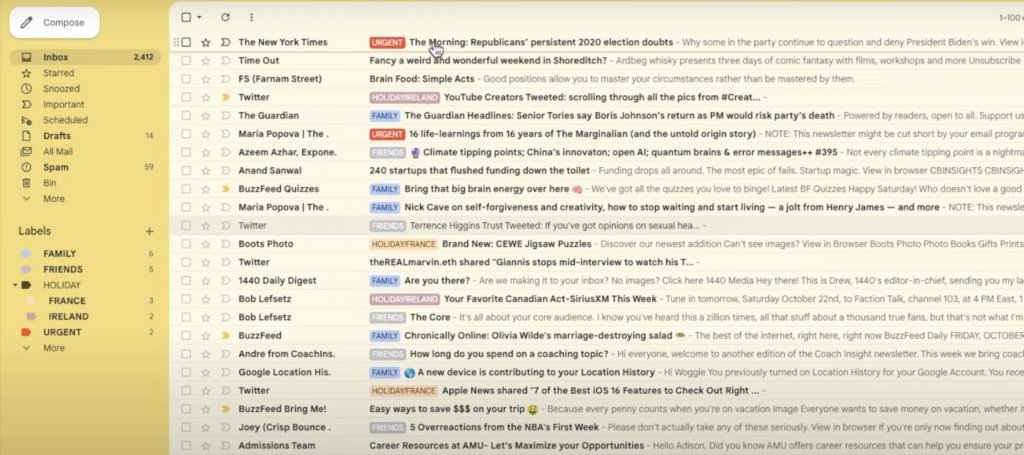
Best practices:
- Avoid creating too many folders and tags for your emails. It can become difficult to locate your emails. At best, you can maintain about 3-4 different folders to organize your emails. Make adjustments according to the number of projects or clients you manage.
- Create a system and stick to it. Choose how you want to name your folders and use it consistently. This way emails will be categorized the same way every time.
- Always update your system to reflect your current work and email needs. Sometimes your initial systems may become outdated and without proper adjustments, emails may become difficult to retrieve.
- Don’t use complex keywords for your tags. Keep it simple and searchable so that you can easily find it whenever you need. It’s also a good idea to use multiple tags on an email to add more context. For instance, an email can have a red tag to mark its urgency, an orange tag to indicate it is from finance, and a blue tag to show that it is an invoice-related email.
3. Use the 2-minute rule
There are some emails that require an immediate response and some that can be actioned later. But putting off non-urgent emails for too long can create a backlog.
That’s why we’d recommend using the 2-minute rule. Basically, if you can respond to an email in 2 minutes or less, go ahead and do it instantly instead of putting it off. Of course, this is not applicable for emails that require a detailed follow-up or response.
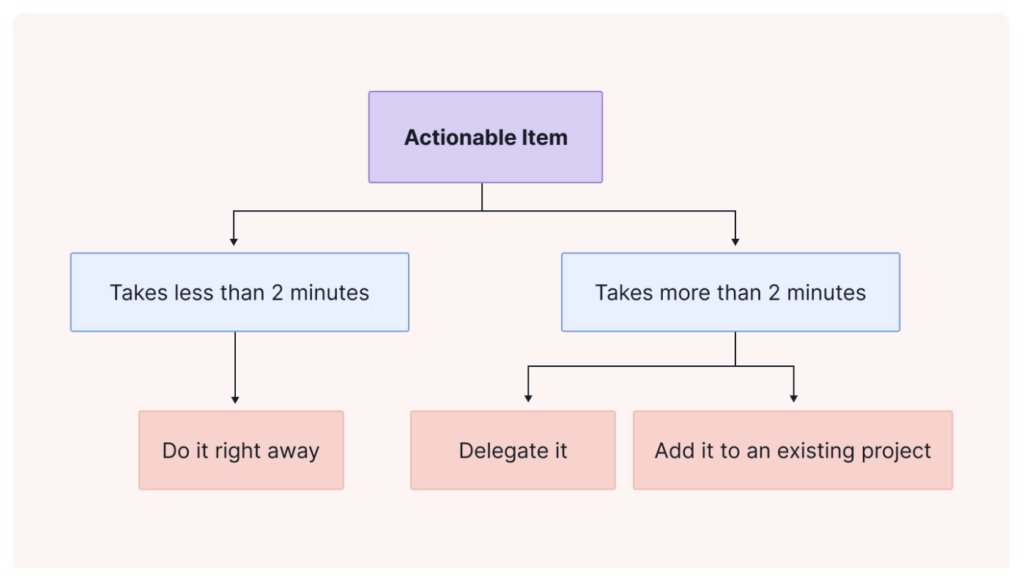
Best practices:
- Frame clear, concise replies for your emails. Refrain from including unnecessary details and if needed, format your responses using headers and bullets for clearer email communication.
- If an email requires more of your time, acknowledge that you have received the email and let the sender know when they can expect a response. For instance, say something like ‘Hey [Name of the Sender], thanks for the update. I’ll get back to you on this by [Date and Time].
- If the email needs to be handled by someone else, assign the email to the concerned recipient and add a quick note to the email for setting context.
For emails that cover multiple concerns or topics, address the most critical one first and offer to respond to the others later.
4. Limit notifications
Nothing is more distracting than the constant ‘pings’ every time you receive a new email. Not only does this affect your focus but it also causes your anxiety to shoot up.
Instead, turn off email notifications on devices when you are focusing on your work outside of your designated email time. Or you can enable notifications only for important emails so that you don’t miss responding to time-sensitive emails.
For instance, Outlook allows you to set custom notifications for emails from specific senders. Similarly, Gmail allows you to turn on notifications only for emails marked as ‘important’.
Best practices:
- If you manage more than two email accounts, turn off notifications for your less critical inboxes. For instance, you can enable notifications only for your work inbox and silence them for your personal inbox during business hours.
- Communicate your availability with team members and stakeholders. Let them know you only check emails at specific intervals so they don’t expect an immediate response from you.
- Audit your inbox regularly and unsubscribe from newsletters and emails you no longer read or require. Lesser the emails, lesser the notifications.
5. Use templates
If you find yourself writing similar responses for different emails, then you might want to think of using canned responses. Email clients such as Gmail and Outlook allow you to create and save your responses as templates.
Any time you’re composing a new email, you can use filters to search for the right template, insert it into your responses, and customize it as you need. This way you can save time and offer consistent communication for repetitive emails.
You can use email templates when sending meeting requests and follow-ups, requesting information, sharing updates, and when acknowledging an email.
Best practices:
- Use placeholders to plug in information such as name, address, and other details. This way you can customize the email so that it sounds less generic.
Make sure that your templates are consistent and reflect the voice and tone of your brand. - Use a mobile-friendly design since a majority of users view emails on their mobile devices.
- Test out different versions of your templates to see which ones elicit the best response. This is particularly applicable in scenarios such as marketing campaigns or customer follow-ups.
- Categorize your templates according to your audience, purpose, and frequency of use. Use simple keywords when naming your templates so that you can quickly access them whenever you need it.
- Try to review your templates on a monthly basis to ensure they include the latest information.
6. Set up auto-responders
Professional courtesy dictates that you respond to every email or at least acknowledge it so that the recipient knows that you’ve received their message and will be responding soon.
Now in cases where you can’t respond in real-time, set up auto-responders for incoming emails. Let recipients know that you are out-of-office and that you will be getting back to them once you’re back. You can customize your auto-responder messages and add enough information so that your intended recipient knows what they should expect.
Here’s an example of how an auto-responder should look like if you’re out of office.
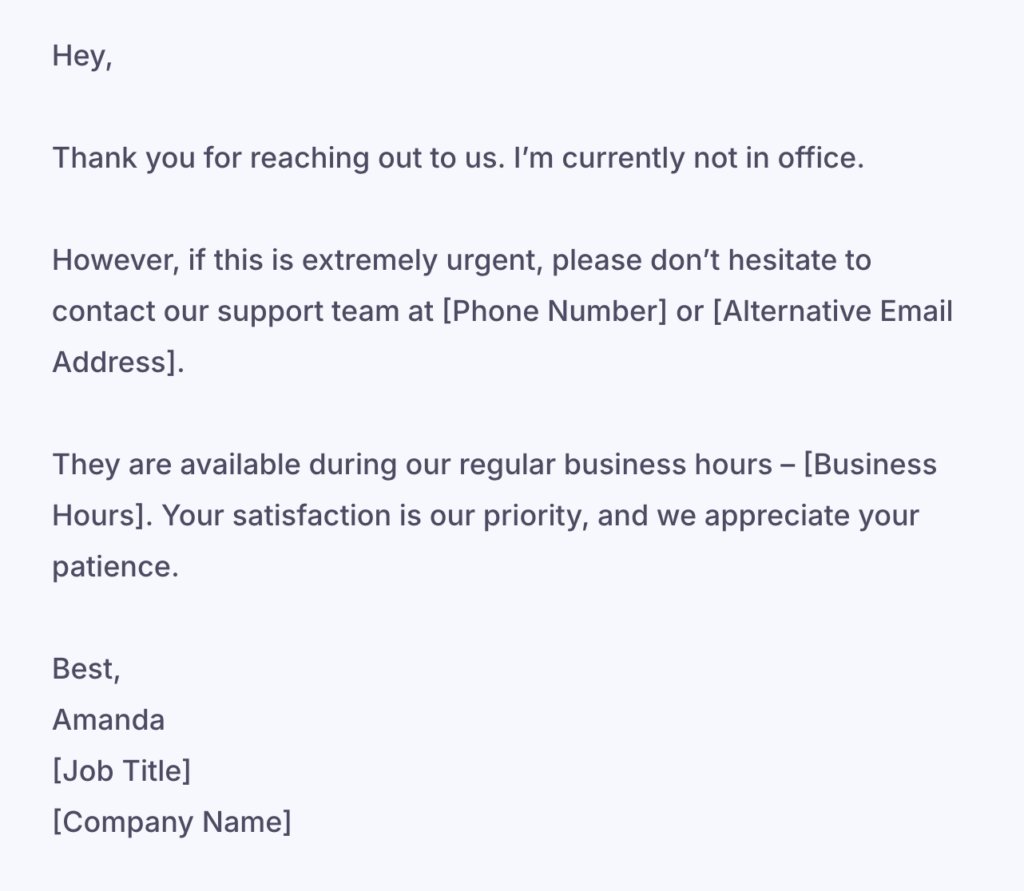
Best practices:
- Include the exact dates during which you will be unavailable.
- For urgent requests, designate and add the contact details of a colleague or manager who will be handling such requests in your absence.
- Keep the email brief and to the point.
- Make sure to clearly state when the recipient can expect a response. It’s a good idea to also mention the time zone you’re working in to avoid confusion.
- Proofread and test the auto-responder before you finalize it.
7. Batch process emails
Batch processing is a productivity hack where you handle groups of emails at a specific time rather than addressing them as and when they arrive.
How to batch process your emails:
Say you process your emails 30 minutes at a time in three sessions – early in the morning, late afternoon, and once in the evening, just before logging out.
In the first session, you delete promotional emails, newsletters, and advertisements. Emails that require a follow-up are moved into a separate folder and a few other emails are delegated to colleagues.
During the afternoon session, you go through the emails in your follow-up folder and spend time drafting responses for these messages.
In the last session, you do a final inbox sweep, handle any urgent emails before you log out and make sure that any new emails that require follow-up are moved into the appropriate folder. Flag emails that need your attention first thing in the morning the next day.
This way you can maintain a clean email inbox and ensure that every email receives proper follow-up.
Best practices:
- Group emails related to the same client, project, or task together so that you can handle them in one go and respond better.
- Avoid checking emails outside of your scheduled batch processing times to maintain productivity.
- Delegate your emails whenever you can to lighten your workload.
- Action every email. You can archive an email, unsubscribe from it, or respond to the message, keeping your inbox clean and organized.
8. Convert important emails into tasks
Say, your manager has asked you to update the sales report for Q3 by Tuesday next week. You make a mental note of this as you move on to the next email. There’s a high chance that by the time you finish sorting through your inbox, you’ve forgotten about the sales report completely.
The problem is that there’s a high chance of incidents like this happening frequently. The best way to handle this is to simply convert emails containing action items into a task. Gmail and Outlook allow you to flag important requests and turn them into tasks with due dates, reminders, and detailed task description. These tasks get added to your to-do list so that important actions are not overlooked.

Best practices:
- Extract the top action items and add detailed task descriptions so you have complete context into what needs to be done. For instance, in the email above, you can create a task description such as ‘Update sales Q3 report with latest marketing and revenue figures’. You can also add the sales report as an attachment to your task so that it is easy to access.
- Always set a due date for the task and customize reminders so that nothing gets missed.
- Categorize your tasks to organize them based on importance, type, project, or priority.
9. Use separate inboxes
If you’re using the same email ID for professional and personal emails, your inbox is going to fill up faster than you can handle. Instead, we recommend creating separate inboxes for different purposes.
Assuming you already have a separate inbox for personal and professional messages, you can also create one to sign up for promotions, newsletters, and free trials. This way your inbox won’t get flooded with non-essential emails and you can ensure that important messages don’t get lost in the noise.
You can even create an inbox for critical emails from important senders so that high-priority messages are always in a single, accessible location. The advantage of creating separate inboxes is that you can batch process emails in each inbox at specific times so that there is a clear distinction between your professional and personal work.
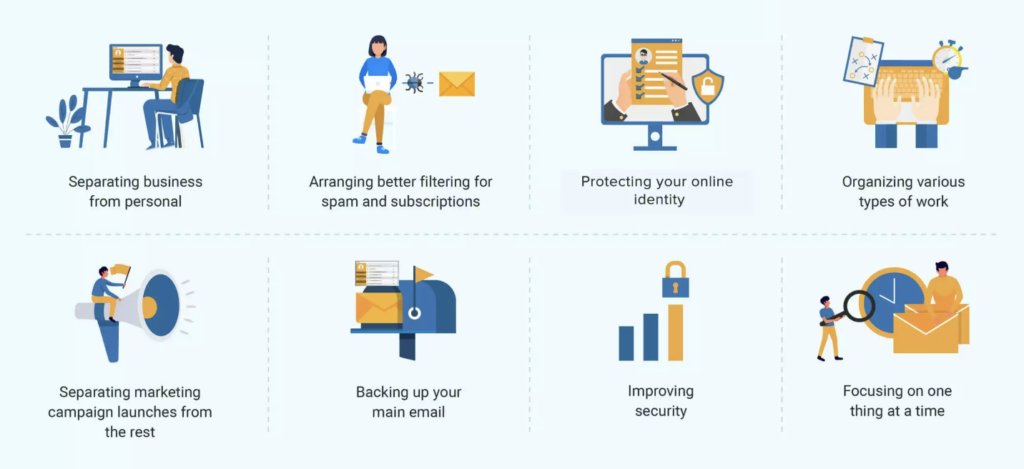
Now, you can create different types of inboxes based on your specific needs and objectives with email management. For instance,
- Primary inbox: The default inbox where you receive the majority of your email communications.
- Personal inbox: This is reserved only for correspondence with friends and family as well as for your online shopping receipts and other personal emails.
- Work inbox: An inbox dedicated to sending and receiving business communication.
- Project-specific inbox: This is meant to centralize communications related to large-scale projects involving multiple stakeholders.
- Role-based inbox: If you manage more than one role in an organization, having role-based inboxes can help you separate your work. For instance, one inbox for managerial work and the other for managing administrative tasks.
- Client-specific inbox: When you deal with multiple, high-value clients, it’s always a good idea to maintain separate inboxes. This way you can keep track of emails from specific clients.
- Newsletter/subscription inbox: Use a dedicated inbox whenever you are subscribing to newsletters and promotional emails. This keeps them separate from important emails and messages.
- Priority inbox: An inbox used for communications from VIP senders and high-priority emails.
- Team inbox: A shared inbox for teams to collaboratively handle communications and tasks. For instance, [email protected] can be used by everyone in the marketing team to sign up for tools or share important updates. This ensures everyone on the team stays informed and aligned with ongoing projects.
10. Use email productivity tools
Supplement your email management efforts with the right tools to amp up your productivity. There’s a wide range of tools (both paid and free) available for multiple use cases such as creating templates, setting up automations, doing spell checks, and more.
These tools can help you streamline email management, reduce inbox clutter, and help you improve your response times.
Here are some email productivity tools that you can use:
- Hiver
- Grammarly
- Boomerang
- Hunter
- EmailAnalytics
- BatchedInbox
- SaneBox
- ProofHub
- Spike
- Mailbird
If you’re curious to know how these tools can help you, the next section in the blog gives you an insight into each tool, highlighting their useful features.
10 Email Productivity Tools for Managing Your Inbox
Here are some of my favorite tools to boost email productivity. Some of these tools may be just what you need to streamline your workflow.
1. Hiver
If you’re looking for a way to seamlessly collaborate on customer queries without leaving your inbox, Hiver is the perfect fit.
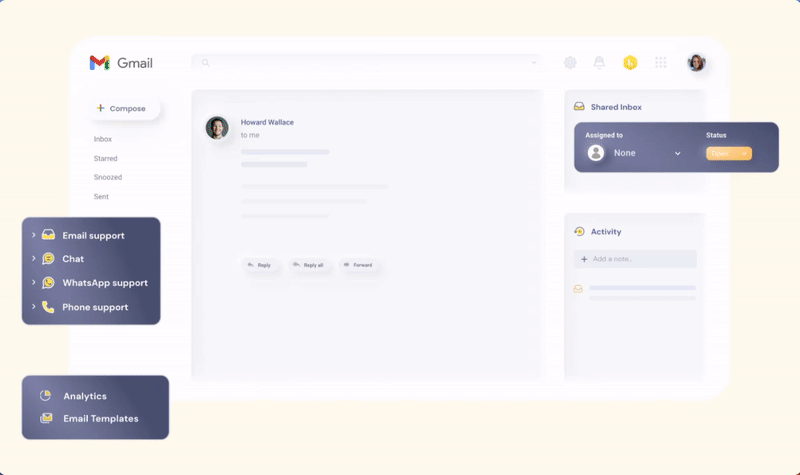
The best part about Hiver is that it is very intuitive and easy to use. Your teams can get started with using the platform in minutes.
Aside from this, Hiver offers several robust features that make email management a breeze.
Here’s what I love about Hiver:
- Shared Inbox: Create inboxes such as [email protected]or [email protected] for your teams. This way team members can work collaboratively on incoming communication and get a clear view of which emails have been handled and which ones need their attention.
- Email Templates: Create and save responses to common inquiries as email templates. Share them with your team so that you can offer quick and consistent responses to your business queries. You can personalize every template using auto-fill variables and even add images, videos, or PDFs as attachments.
- Notes and @mentions: Use notes to collaborate with team members on customer queries. These notes open up alongside every email and save you from all the unnecessary forwards, CCs, and endless email threads. Instead simply @mention a colleague you want inputs from – they are immediately notified and can respond with their insights.
- Email Tags: Use color-coded tags to neatly categorize your emails according to their type or priority. This makes it much easier to access your emails and ensure that critical emails receive immediate attention.
- Automations: Configure conditions so that every incoming email is routed to the right agent based on their expertise or workload. For instance, you can define a trigger by which emails with the word ‘Payment’ in the subject line or message body will be routed to the finance specialists on your team.
- Email Status: A personal favorite among customers, Hiver allows you to view the status of all the emails in your inbox by categorizing them as ‘Open’, ‘Closed’, or ‘Pending’. This is a great way to understand which emails are pending action and tackle them according to their importance.
Aside from these, I also like the AI Summarizer feature. If you don’t want to read through endless email threads, use the AI summarizer to condense the entire email conversation into easy-to-read notes. This proved to be super useful whenever I wanted to give quick context behind a customer issue when handing off an email to a colleague. The AI summarizer highlights all the key points in the email thread, making it much easier for me to explain critical action items for smoother handoffs.
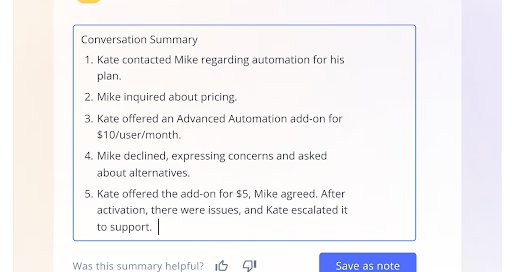
Pricing:
Hiver has a four tiered pricing plan that starts at $19 per agent per month.
2. Grammarly
This tool needs no introduction. You may have used Grammarly at some point in your life, at least just to do basic grammar and spell checks.
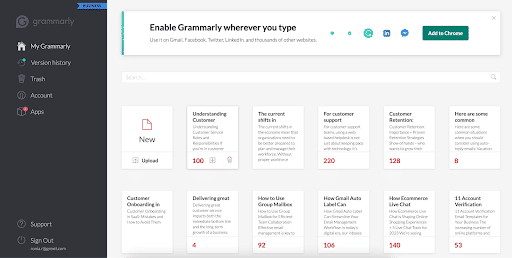
But did you know Grammarly can significantly enhance email productivity? The platform offers several other robust features that can help you save a lot of time when you’re composing emails. It boasts AI features that can improve the style of your writing and generate contextual responses in no time.
Here’s what I love about Grammarly:
- On-demand AI: Grammarly’s AI-assistant acts like a consultant and helps you refine the tone and style of your message to suit the context of what has to be communicated. Simply input a prompt and the AI assistant will generate ideas and outlines for your email messages. The AI can even summarize an email and give you insights into the sender’s intent. You can choose from a list of suggested, ‘ways to reply’ prompts to decide how you want to respond to the sender.
- Strategic Coaching: Get personalized suggestions based on the topic you’re writing so that what you write resonates with your audience. It goes beyond simple grammatical feedback and actually helps you tailor your writing to specific goals. For instance, say you’re writing an email to a customer, citing a few changes that need to be made to their marketing strategy. You run the email through Grammarly and the Strategic Coaching feature gives you writing suggestions to strengthen your argument such as adding data or evidence, emphasizing on the benefits, and adding a strong CTA.
- Snippets: If you find yourself writing the same messages over and over again, Grammarly Snippets can help you save some time. You can create message templates for such repetitive emails and save them to Grammarly using simple keywords. The next time you start composing a message, simply add /[the keyword used] to insert the template into your email.
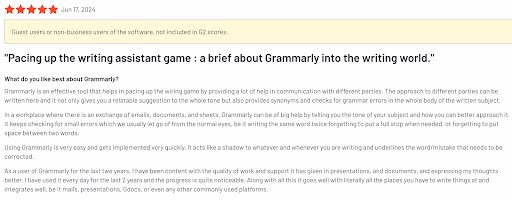
My personal favorite has to be the Knowledge share feature. How many times have you come across business documents and emails where you’re not familiar with some of the terms used? Imagine how many employees must be Googling these terms or pinging their colleagues to understand the meaning of such jargon?
That’s where I found this feature useful. Grammarly allows you to create what is known as ‘Knowledge Share Term’ when composing documents. You add a description of the term, include links to relevant documents associated with it, and even add contacts for POCs to ask for help.
What this means is that any time an employee reading this email comes across this term, they get quick access to all the information associated with it without moving away from their email inbox. No need to search for information across multiple locations. This way everyone can stay on the same page easily.
Pricing:
Grammarly has a free plan that offers basic editing and spell check features. If you want their advanced features you will have to opt for either their Premium plan priced at $12 per month or their Enterprise plan that costs $15/agent per month.
3. Boomerang
Boomerang is a simple Chrome extension that helps you with efficient meeting scheduling and email management.
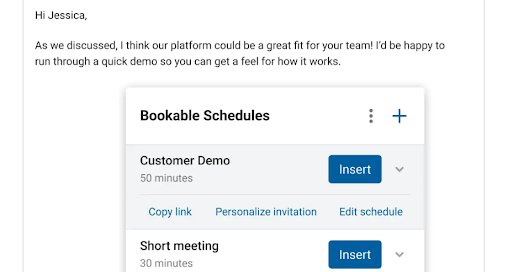
It is a super useful tool that can help you eliminate the stress of booking meetings, responding to emails on time, and writing compelling emails.
Here’s what I love about Boomerang:
- Respondable: Craft perfectly worded emails with the help of Boomerang’s AI assistant. Armed with insights from millions of messages, Respondable helps you write emails that are concise, contextual, and effective. You can easily adjust the tone of your emails and make it more actionable by leveraging real-time suggestions from Respondable.
- Email Boomerangs: If you don’t want a cluttered inbox, but still need to keep track of your emails, Boomerang has a solution. You can archive emails for a specific period of time until you are ready to tackle them. The email will be temporarily removed from the inbox and will reappear at the scheduled time as an unread message at the top of your inbox. This way you can maintain a cleaner inbox without losing important communication.
- Email Reminders: Follow-up with people who haven’t responded to your sent emails by setting up follow-up reminders using Boomerang. You can choose when you want to be reminded and whether you want to be reminded only if no one responds to your email or regardless. This way you can ensure that critical emails receive attention on time.
- Meeting Scheduler: Avoid the endless back and forth that goes into scheduling meetings with external or internal teams. Simply set up a schedule of your availability on Boomerang and share it with anyone you choose over email. All your guest has to do is click on a slot that suits them and that’s it, the meeting is scheduled. You can even create team schedules based on the availability of your team members by automatically finding time slots that work for everyone. This increases the show rate to your meetings and makes them more effective. Freelance consultants and contractors in particular, benefit from this feature. This is because, unlike in a company, where everyone has visibility into their coworker’s calendar, freelancers cannot see when you’re available or not. In such situations, Boomerang takes the stress out of scheduling meetings.

However the star of the show for me is the InboxPause. Basically you define a schedule during which new emails do not come into your inbox.
This way you are not compelled to check your inbox every now and then and can actually focus on your work. And if you’re worried about missing important timelines, you can set delivery exceptions to allow critical messages to get through. For all other emails, set up an auto-responder to notify recipients that your inbox is paused and they will be hearing back from you shortly.
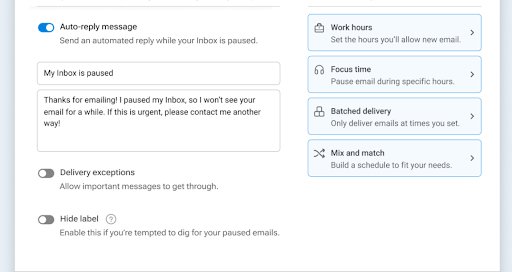
Pricing:
Boomerang has a free plan for a limited number of message credits. Their paid plan starts at $4.98 per month and goes up to $49.98 per month.
4. Hunter
Spending too much time trying to find the right contact information to reach out to leads or to connect with people that matter? Use Hunter.
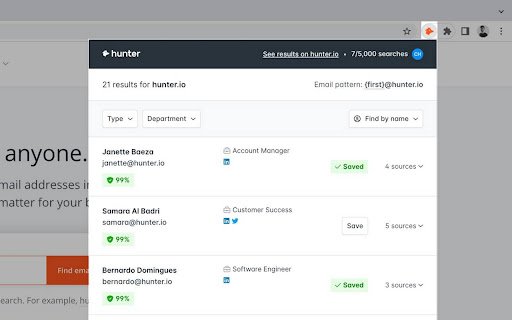
Hunter uses a combination of proprietary technology and AI to search and find the professional email IDs of the people you want to connect with. Not only does the tool help you find email addresses but it also verifies them for you, ensuring that your emails always reach the right person.
Here’s what I love about Hunter:
- Email Finder: Find the email address of any professional either by inputting their name or the company name. This way you can easily reach out to the key stakeholders in any business. Hunter searches through the web and multiple other databases to surface publicly available email addresses. Each email ID has a confidence score, department filters, and sources added to it so that you can verify the addresses.
- Discover: Essentially a B2B lead database that offers powerful market segmentation including firmographic, technographic, and industry filters. You can find qualified leads to reach out to using the intent based filters. This way your sales reach out is targeted towards leads that actually have a higher chance of converting to customers. This is also a favorite among users.
- Signals: Develop the customer profile for your next target by extracting important information from news and events related to these profiles. You can use Signals to identify a prospect’s intent and evaluate whether they need your solution and when they need it. This way you can reach out to valuable prospects at the right time. This feature takes the guesswork out of prospecting and helps you dive deeper into intent data to identify warm prospects.

The feature that stood out most to me however, was Hunter Campaigns. It is a simple feature that allows you to send highly targeted cold emails to your prospects. You can personalize the email and schedule it to be sent whenever you want. The best part is that you can track exactly which emails get clicks and opens and even identify which leads have opened your emails without engaging.
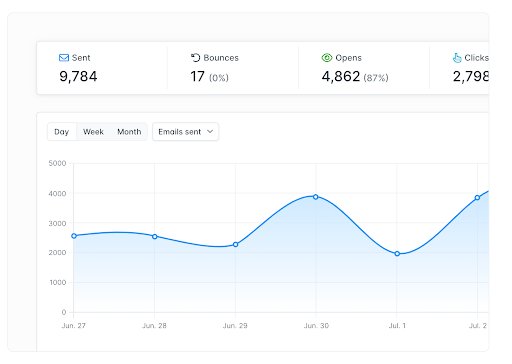
Pricing:
Hunter offers a free plan with limited features. Its paid plans start at $408 per year and go up to $4,188 per year.
5. Email Analytics
Email Analytics offers a comprehensive analytics solution to track how your team is using email and to help them improve their response time.
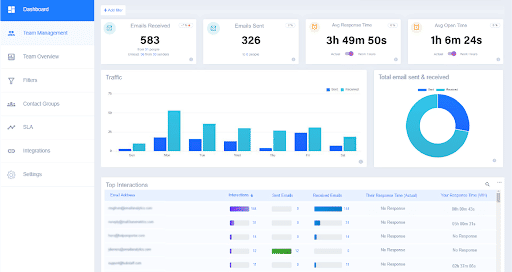
The platform is great for getting a sense of things like how many emails your team members send and receive every day, how many contacts they correspond with, and even to track the number of spam messages they receive. Email Analytics is compatible with any email client and you can simply sync it with your existing email analytics dashboard.
Here’s what I love about Email Analytics:
- Email Traffic: Monitor the volume of emails sent and received by your team on a daily basis. Find out which days are the busiest for your teams so that you can assign workloads accordingly.
- Email Traffic by Label: If your team uses labels and folders to organize their emails, you can get a complete view of how many unread messages are there in your team’s inbox. Keep track of how efficiently your team handles critical messages by monitoring the number of emails marked ‘Important’.
- Email response time: Track how long it takes for your team to respond to emails. It differentiates between actual response time (responses are sent to emails as they come) and work hours response time (responses sent to emails only during work hours) so that you understand how responsive your team is and how productive they are during their work hours.
I also loved the fact that you can set SLAs for your team so that they always respond to every email within an acceptable time frame. You get a real-time feed of every email your team has received and can track whether they have been responded to or not. This is a great way to keep your teams accountable and ensure every email receives a timely, acceptable response.
Pricing:
EmailAnalytics offers a two tiered pricing plan with its Pro plan at $15/inbox per month and its B2B plan at $1000 per month.
6. SaneBox
Tackle an overflowing inbox with SaneBox’s inbox management features. Instead of spending precious time sorting through a list of never-ending emails, hand it over to SaneBox.
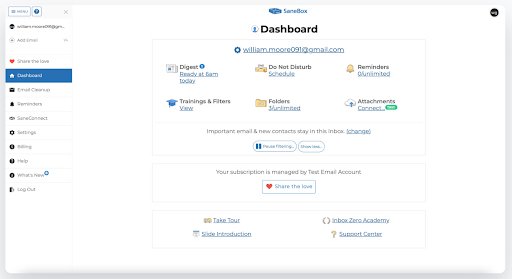
The platform automatically filters unimportant emails and organizes them into different folders so that you can take a look at them later. It helps you focus on important emails and even has a snooze button that allows you to pause emails until you’re ready to work on them.
Here’s what I love about SaneBox:
- Inbox Management: SaneBox has a powerful AI feature that automatically moves unimportant emails out of your primary inbox and into separate folders. You can teach the AI which emails go where with a drag-and-drop functionality and it will follow the same pattern to organize all your incoming messages. This way your inbox is not overflowing with unnecessary emails. Many users report that SaneBox saves them plenty of hours during their work week.
- Do Not Disturb: Block incoming emails for a specific duration such as when you’re in meetings, focusing on important work, or outside of work hours. This minimizes distractions from email and helps you work better.
- Sane BlackHole: If you’ve also experienced unsubscribing to newsletters only to have them pop back in your inbox, this feature can help you. SaneBox routes all unwanted email to the SaneBlackHole folder so that you never have to see them in your inbox again.

I also tested out the SaneNoReplies feature and found it super useful. It keeps track of all the emails you’ve sent that have not yet received a response and stores them in a separate folder. You can see which emails are pending replies and set up follow-up reminders to help you reach back to the recipients.
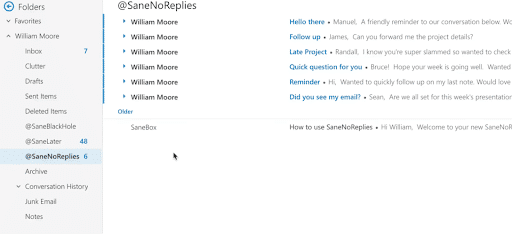
Pricing:
There are three pricing plans that start at $3.49 per month and goes up to $16.99 per month.
7. Spike
Spike converts your email threads into real-time chat so that you can communicate seamlessly with your contacts. If you’re not someone who is fond of the traditional email interface, Spike offers you a conversational experience so you don’t have to follow what’s happening on endless, messy email threads.
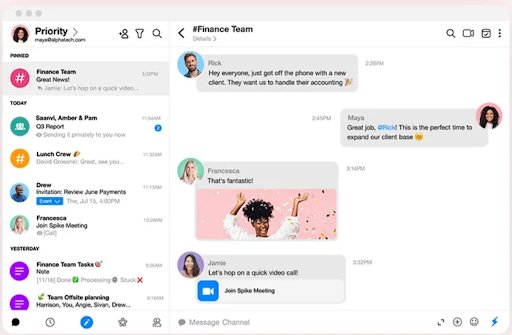
The platform allows you to respond faster to email communications and makes sure that you never miss anything important.
Here’s what I love about Spike:
- Conversational Email: Transform messy email threads into chat messages, making email responses faster and easier. Group all your communications by contact so that you can easily pull up past conversations, attachments, or files by simply clicking on the contact profile.
- Groups: Collaborate with anyone (outside or inside your organization) you choose by creating a group and inviting them to it. Chat about any topic in real-time without sending unnecessary emails every time.
- Video Meetings: Jump on a video call in seconds from any chat or email thread. Instead of switching between multiple applications, Spike allows you to chat, email, or video call anyone from a single platform. You can conduct video meetings or audio calls for better collaboration.

I also loved the Collaborative Docs feature which is essentially a shared document where you can invite team members to discuss ideas, explain concepts, and create company wikis. You can invite anyone to collaborate on the doc, irrespective of whether they work outside or inside your company. You can tag people, leave comments, and jot down your thoughts and ideas without opening yet another application.
Aside from this, you can even add tasks to the document and assign them to the right team members so that you can get your work done effectively.
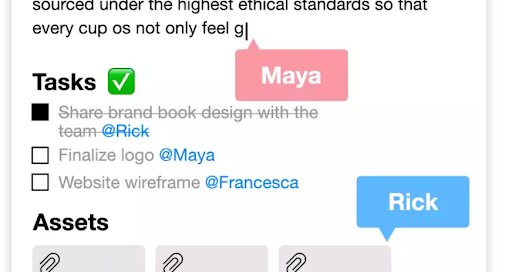
Pricing:
Spike has a free forever plan with limited features. It also has two pricing options that costs $5 per user per month on the lower end. Its Ultimate plan is priced at $10 per user per month.
9. MailBird
Remember the email productivity tip on creating multiple inboxes for managing your emails? Well, MailBird allows you to manage different email accounts from a unified inbox.

This way, instead of switching between multiple email clients, you can see emails from various accounts in a single place and respond to them with ease. The platform has a customizable interface that allows you to make the email management process more personalized and aligned with your unique workflow.
Here’s what I love about MailBird:
- Centralized Email Management: Manage all your email accounts from a single location and avoid switching between multiple email providers and inboxes to get your work done.
- AI-powered Email Authoring: Use ChatGPT to quickly craft effective emails that sound human-like instead of manually writing messages from scratch.
- Customizable Notifications: Set a different notification tone for each inbox by either choosing from MailBird’s selection of sounds or by uploading a notification tone of your preference.
- Keyboard Shortcuts: Use built-in shortcuts on your keyboard for composing emails, sending a reply, or forwarding a message. This makes email management so much easier and more efficient.
What I love most about MailBird is that the platform supports several languages. This makes it incredibly accessible for people from different linguistic backgrounds.
Pricing:
MailBird has a free plan along with two paid plans. The lower end costs about $2.28 per month while the highest pricing plan costs you $49.50 per user.
10. BatchedInbox
BatchedInbox is the perfect solution for anyone who batch processes their emails for better productivity. The platform (meant for Gmail) delivers emails to your inbox only at specific times during the day. This way you don’t get distracted when you are in the midst of deep work.
Every incoming email will be routed to a separate Gmail folder where it will stay until the time you’ve specified. If you want to get a quick preview of your emails, simply search for the label BatchedInbox and you can see which emails are in the folder. You can also set filters so that emails from certain contacts bypass the rules and are sent to your inbox.
Pricing:
BatchedInbox is a free tool.
Take Control of Your Inbox and Boost Email Productivity
Having to constantly sort and organize your inbox can cause distractions and interfere with your work.
However, with the right email productivity hacks and tools you will be able to maintain a clutter-free inbox and prioritize critical communications with ease.
Using the tools above can help you categorize your emails, track your response times, and snooze emails so that you can focus on deep work. These tools can help you take control of your email habits and transform your inbox from a source of stress into a more manageable part of your workflow.











